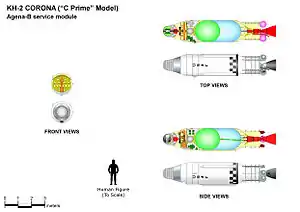 | |
| Mission type | Optical reconnaissance |
|---|---|
| Operator | US Air Force/NRO |
| Harvard designation | 1961 Pi 1 |
| COSPAR ID | 1961-016A |
| SATCAT no. | 00160 |
| Mission duration | 2 days |
| Spacecraft properties | |
| Spacecraft type | Corona KH-2 |
| Bus | Agena-B |
| Manufacturer | Lockheed |
| Launch mass | 1,150 kilograms (2,540 lb) |
| Start of mission | |
| Launch date | 7 July 1961, 23:29:48 UTC |
| Rocket | Thor DM-21 Agena-B 308 |
| Launch site | Vandenberg LC-75-3-5 |
| End of mission | |
| Decay date | 5 December 1961 |
| Orbital parameters | |
| Reference system | Geocentric |
| Regime | Low Earth |
| Perigee altitude | 229 kilometers (142 mi) |
| Apogee altitude | 713 kilometers (443 mi) |
| Inclination | 82.9 degrees |
| Period | 94 minutes |
.gif)
Discoverer 26, also known as Corona 9019, was an American optical reconnaissance satellite which was launched in 1961. It was the sixth of ten Corona KH-2 satellites, based on the Agena-B.[1]
The launch of Discoverer 26 occurred at 23:29:48 UTC on 7 July 1961. A Thor DM-21 Agena-B rocket was used, flying from Launch Complex 75-3-5 at the Vandenberg Air Force Base.[2] Upon successfully reaching orbit, it was assigned the Harvard designation 1961 Pi 1.
Discoverer 26 was operated in a low Earth orbit, with a perigee of 229 kilometres (142 mi), an apogee of 713 kilometres (443 mi), 82.9 degrees of inclination, and a period of 94 minutes.[3] The satellite had a mass of 1,150 kilograms (2,540 lb),[4] and was equipped with a panoramic camera with a focal length of 61 centimetres (24 in), which had a maximum resolution of 7.6 metres (25 ft).[5] Images were recorded onto 70-millimeter (2.8 in) film, and returned in a Satellite Recovery Vehicle, which was deorbited two days after launch. The Satellite Recovery Vehicle used by Discoverer 26 was SRV-511. Once its images had been returned, Discoverer 26's mission was complete, and it remained in orbit until it decayed on 5 December 1961.[3]
References
- ↑ Krebs, Gunter. "KH-2 Corona". Gunter's Space Page. Retrieved 23 October 2020.
- ↑ McDowell, Jonathan. "Launch Log". Jonathan's Space Page. Retrieved 26 June 2010.
- 1 2 McDowell, Jonathan. "Satellite Catalog". Jonathan's Space Page. Retrieved 26 June 2010.
- ↑ Wade, Mark. "KH-2". Encyclopedia Astronautica. Archived from the original on 23 October 2012. Retrieved 26 June 2010.
- ↑ "Corona". Mission and Spacecraft Library. NASA. Archived from the original on 3 October 2007. Retrieved 26 June 2010.